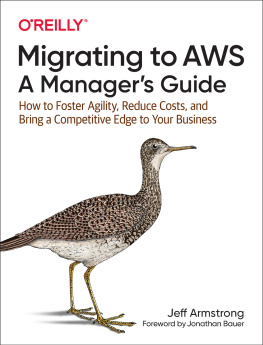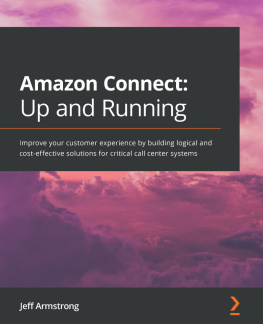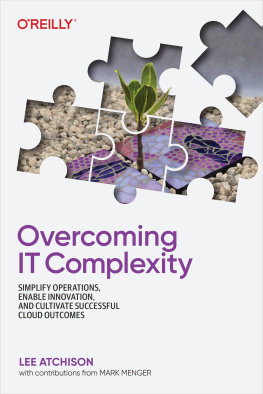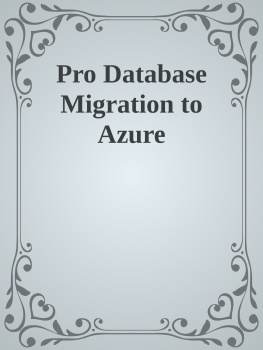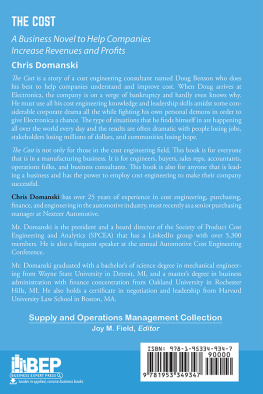Migrating to AWS: A Managers Guide
by Jeff Armstrong
Copyright 2020 Jeff Armstrong. All rights reserved.
Printed in the United States of America.
Published by OReilly Media, Inc. , 1005 Gravenstein Highway North, Sebastopol, CA 95472.
OReilly books may be purchased for educational, business, or sales promotional use. Online editions are also available for most titles (http://oreilly.com). For more information, contact our corporate/institutional sales department: 800-998-9938 or corporate@oreilly.com .
- Acquisitions Editor: Jennifer Pollock
- Development Editor: Amelia Blevins
- Production Editor: Kate Galloway
- Copyeditor: nSight, Inc.
- Proofreader: Shannon Turlington
- Indexer: nSight, Inc.
- Interior Designer: David Futato
- Cover Designer: Karen Montgomery
- Illustrator: Rebecca Demarest
Revision History for the First Edition
- 2020-06-26: First Release
See http://oreilly.com/catalog/errata.csp?isbn=9781492074243 for release details.
The OReilly logo is a registered trademark of OReilly Media, Inc. Migrating to AWS: A Managers Guide, the cover image, and related trade dress are trademarks of OReilly Media, Inc.
The views expressed in this work are those of the author, and do not represent the publishers views. While the publisher and the author have used good faith efforts to ensure that the information and instructions contained in this work are accurate, the publisher and the author disclaim all responsibility for errors or omissions, including without limitation responsibility for damages resulting from the use of or reliance on this work. Use of the information and instructions contained in this work is at your own risk. If any code samples or other technology this work contains or describes is subject to open source licenses or the intellectual property rights of others, it is your responsibility to ensure that your use thereof complies with such licenses and/or rights.
978-1-492-07424-3
[LSI]
Foreword
Im a golfer (thanks in advance for the sympathy)I started playing as a teenager. As a kid, I played baseball and tennis. When it was time to play golf, I just picked up a club. How hard could it be? I already understood foot position, grip, weight shift, and follow-through. To suggest I wasnt very good for the first 15 years I played golf would grossly understate just how bad I was at the sport. What I came to realize was that, while there were numerous similarities, the subtleties of the swing in each sport were very different and appreciating the differences was important. Well get back to this.
For the first 15 years of my professional career, I worked in IT. I managed large IT programs in the mid-late 1990s, during the boom of the large enterprise resource planning (ERP) transformations. There were several drivers for these transformations as the year 2000 approached. For some companies, significant growth over the past several yearsincluding expansion from the dot-com explosionled to the need for transformation and reengineering. Global companies needed to transform as well, but the scale and architectural constraints imposed by their geographic requirements often led to ERP instances in multiple geographic regions. Lastly, for companies with large legacy mainframe systems, the large ERP was a means of fixing the most famous Y2K problem: six-digit date mathematics.
By the time 2001 rolled around, many CIOs were challenged to quantify the value their recent large ERP programs delivered. In the early 2000s, many companies intended to transform by leveraging an ERP implementation, but the programs became so complex and costly that they dropped the transformative aspects of the effort and resorted to simply implementing the technology, failing to deliver many of the anticipated results. Then, a couple years later, many CIOs and their key business colleagues went through an ERP second wave effort. These programs were much less technology focused. Instead, the focus was on the transformational agenda: optimizing processes, reducing costs, standardizing operations and architectures around the globe, and getting products to market faster. Most companies recognized the needed benefits.
I would suggest that both analogies are relevant to the world in which we find ourselves today, migrating workloads to the cloud.
On one level, migrating to the cloud is like other significant IT activities, but its important to look at the details. Like every good IT shop, there is a strategy, tightly linked to the business objectives, and a team of people with the right knowledge and skills to execute. Migrating to the cloud is no different; what is different is that the skills, knowledge, methods, and capabilities required to migrate, execute, and then operate migrated workloads are often different than those required in our traditional on-prem world.
In 2020, we find ourselves in an analogous situation, as many CIOs havent realized the benefits for moving workloads to the cloud. There are several reasons. First, we see corporations start their cloud journey without defining why they plan to move workloads to the cloud. Whats the strategy? Are you trying to close data centers? Reduce IT costs? Are you trying to move critical workloads to the cloud to take advantage of cloud native services? For those companies that do define these goals, there is inadequate governance that prioritizes investments to help guide the company toward achieving its strategy. As a result, workloads get to production with inconsistent architecturesperhaps on different clouds, inefficiently using cloud resources, and, frequently, without the necessary security to keep the information safe. It can be difficult to correct these issues quickly. Shifting to the cloud effectively and efficiently requires a thoughtful plan and a good deal of preparation from the business and IT.
Second, to migrate workloads to the cloud and operate them, a company needs cloud skills in many areas. Most of the skills categories resemble those categories required in their on-prem world. The topics are well known: infrastructure, security, development/programming skills, tools, DevOps, and much more. Some of these topics are reasonably easy to understand and appreciatefor example, the good migration tools available on the market are easy to review and score. However, the effort to transition from your traditional software development life cycle to DevOps takes time and practice from people in both IT and the business.
Just as the golfer with an awesome baseball and tennis swing needs to adjust to the nuances of golf, so must an organization transition from on-prem to cloud skill sets and processes.
Lets compare the golfers skills to the shift toward cloudwe will evaluate the stance, the swing, and the grip. The golf stance is the cloud landing zone: its the foundation on which everything is built. There are so many options that influence your workload performance, your backup and disaster recovery options, and your global data storage requirements. The company strategy will provide requirements that affect the landing zone design. Your migration swing is the set of tools used to execute the migration. The swing moves the objects from location A to B. There are tool sets that can be used to automate the movement of applications into their landing zones, including mission-critical mainframe workloads. The grip is the reliable set of hands that are required to execute the swing. Instead of holding a seven-iron, youre placing your hands on the AWS console, and you need the right skills and knowledge to execute successfully. Building a team with the required cloud skill sets to migrate and operate cloud workloads is frequently underestimated.

